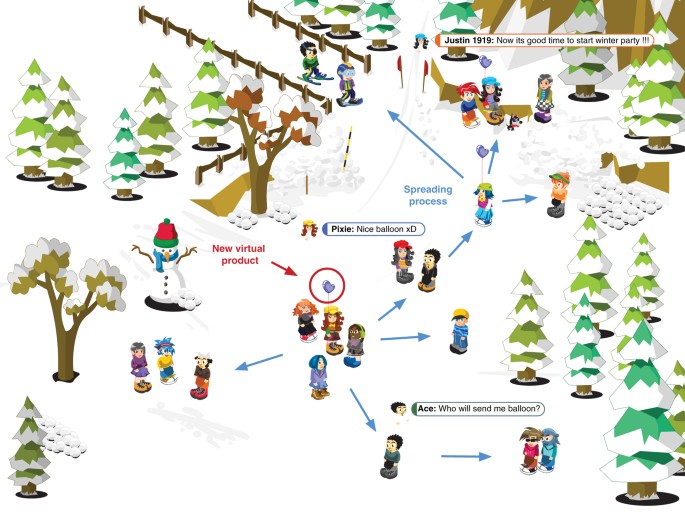
- Select a language for the TTS:
- UK English Female
- UK English Male
- US English Female
- US English Male
- Australian Female
- Australian Male
- Language selected: (auto detect) - EN
Play all audios:
ABSTRACT Presented data contains the record of five spreading campaigns that occurred in a virtual world platform. Users distributed avatars between each other during the campaigns. The
processes varied in time and range and were either incentivized or not incentivized. Campaign data is accompanied by events. The data can be used to build a multilayer network to place the
campaigns in a wider context. To the best of the authors’ knowledge, the study is the first publicly available dataset containing a complete real multilayer social network together, along
with five complete spreading processes in it. Design Type(s) innate behavior design • decision analysis study design Measurement Type(s) Influence Technology Type(s) data collection method
Factor Type(s) Incentive Sample Characteristic(s) Homo sapiens • Virtual Reality Machine-accessible metadata file describing the reported data (ISA-Tab format) SIMILAR CONTENT BEING VIEWED
BY OTHERS AGENT-BASED NULL MODELS FOR EXAMINING EXPERIMENTAL SOCIAL INTERACTION NETWORKS Article Open access 31 March 2023 QUANTIFYING AGENT IMPACTS ON CONTACT SEQUENCES IN SOCIAL
INTERACTIONS Article Open access 03 March 2022 THE CONNECTIVITY NETWORK UNDERLYING THE GERMAN’S TWITTERSPHERE: A TESTBED FOR INVESTIGATING INFORMATION SPREADING PHENOMENA Article Open access
08 March 2022 BACKGROUND & SUMMARY Information spreading within electronic systems has attracted substantial research interest in recent years. Studies have investigated spreading
processes in email exchange1, social platforms2, virtual worlds3, online games4, blogs and other forms of online publishing and communication5. The types of content include videos6, images7,
news8, information about promotions9, rumours10, and virtual goods11–13. Research in the field includes seeding strategies for selection of initial nodes which start diffusion
processes13,14, factors affecting the forwarding of content15, the role of emotions5 and the performance of viral campaigns16. Virtual worlds and online games create interesting environments
having the ability to monitor content diffusion with mechanics close to the real systems. Users, represented by avatars in synchronic environments, perform actions similar to real world
face-to-face communication, with direct contact between content sender and recipient. The level of interaction and the content sharing is influenced by factors similar to those occurring in
the real world, such as visual characteristics, social ties, activity within groups and emotions. Virtual worlds can be treated as laboratories for analysis and observing social and economic
phenomena17. Virtual worlds have been used for studying the dynamics of infectious diseases18, virtual goods transmission11,12, visual factors affecting the spread of information3. While
several online repositories publish data from social networking platforms, datasets from virtual worlds (especially those related to information spread) are difficult to acquire. Virtual
worlds and games have typically closed structures and lack open APIs to access data. One of the reasons is the fact that social networking platforms are dominated by leaders like Facebook or
Twitter. In contrast, the online game market is fragmented with hundreds of systems which are available online19. Operators of online games and virtual worlds are often apathetic towards
sharing internal data, thus making it difficult to do research in the field. Datasets presented in the current study reveal aspects of digital content spreading within virtual worlds showing
several different mechanics. Data from viral campaigns, system use statistics and the multilayer structure of the network based on social relations, messages, virtual currency transfers and
social interactions within virtual rooms each offer areas for research in the field of information spreading. METHODS The presented dataset covers data from dedicated viral campaigns within
the virtual world, with the main focus being on spreading virtual goods. Campaigns were conducted within Timik.pl—a virtual world platform available for users in Poland, and providing chat
functions and various forms of entertainment. Users are represented by graphical avatars, each having the opportunity to engage in the life of online community. Since the system launch in
2007, over 850,000 accounts have been activated. The platform was fully operational between 2007 and 2012. All analysed campaigns were based on attempts to introduce new virtual product
(graphical avatar in all cases) to the users with the use of spreading and social influence mechanics. Instead of adding new object to the system and make it available to all users, a small
number of random users was selected for each campaign as a seeds and they received the products first. Then they had possibility to spread it among other users. The data collection process
from the Timik.pl platform was reviewed by the Ethics Committee for Human Research at SWPS University of Social Sciences and Humanities (Wrocław Faculty, Poland). The Committee did not have
any objection to the process. In order to use the platform, each user had to agree that data related to user behavior can be processed for statistical analysis and made available to external
entities for analytical and research purposes after encoding, without possibility to identify any specific users. The aforementioned Ethics Committee confirmed that the dataset is in
compliance with Polish law, ethical standards, and the terms of use of the Timik.pl platform. Users communicate in the space of public graphical rooms which are associated with different
themes. They can configure and furnish their own private rooms as well as use online games and different entertainment options. The basic service function relates to communication,
establishing social relations, meeting new people and chatting. Avatars and decorative elements, styles, clothes and virtual products are other features. Viral content can be distributed
through private messages delivered with the use of internal communication system. Analytical module enabled monitoring the spread of the content and gathering data related to information
diffusion processes. Users have access to a number of generally available functions as well as paid premium services, which provide additional possibilities. In extended packages, there are
sets of avatars, clothes and special effects available. There is a store where users can buy virtual objects, and an auction system which functions as a secondary market. Free of charge and
paid service elements are introduced into a system, but at different frequencies. To improve the ability to interact with other users, mechanics were used to transfer virtual goods between
user account, and this was implemented for several campaigns. Virtual goods are in the form of avatars, special effects for avatars or products equivalent to real goods. Special commands
implemented in the system give users the possibility to transfer virtual goods between accounts. Figure 1 illustrates the typical situation when a user who has acquired a new virtual product
shows such a product to others. The interaction builds interest in the new product and it can be transmitted to other users with content spreading process observed. The presented dataset
includes data from five campaigns based on new virtual products implemented within the system. In each campaign, the new product was delivered to randomly selected users. They were able to
spread it among other users, and each transmission event was registered in the system. Designed campaigns used two mechanics to evaluate its influence on campaigns dynamics and
effectiveness. Similar case was with incentives in one of campaigns. Different configurations of the campaigns were the attempt to find an optimal configuration for the best strategy for new
product introduction and increasing user engagement in a new product spreading for future campaigns. As for the campaigns, it was discovered that the following factors affected performance:
content type, content transmission mechanics, content quality and incentives. Content type: the virtual products designed for viral transmission were delivered in the form of thematic
avatars, making users more unique within the virtual world. The avatars used for viral campaigns were different from those who were previously available within the system. The only way to
get new avatars was by receiving them from the other user. Content transmission mechanics: the asynchronous system provides opportunities to implement content sharing mechanics. Two types of
mechanics were used for transmitting content between user avatars. The first possible way of content transmission used was by clicking on the recipient’s avatar. It was considered as low
resistance (LR) transmission with a low effort needed to transmit the content and no social relation required between sender and receiver. It was used in one campaign. The second
transmission method required more effort and was based on special messages sent between users through the use of the internal messaging system. It required the existence of the receiver on a
list of friends of sender and was considered as high resistance (HR) transmission. It was used in four campaigns. Content quality: Users had access to basic avatars in the system available
for free. Extended versions with higher quality were available for premium paid accounts. Differences in the quality were noticeable to users. Premium avatars were more detailed and
colorful, and it was possible to distinguish among users. In four of the analysed campaigns, higher quality content (which was more similar to premium accounts) was used, and content similar
to basic accounts was implemented in one of them. Incentives: motivation to spread content to other users in viral campaigns can be based on spontaneous need of sharing content; this takes
place in many online viral actions. Push and pull mechanisms are the main drivers of viral campaigns. Marketers use incentives to motivate users to share content for the purposes of
increasing the dynamics of information spreading processes. In order to observe effect of incentives in one of five campaigns, incentives were used and users spreading content took parts in
the contests with prizes given to the most active spreaders. Taking previous assumptions into account, campaigns were conducted with different diffusion mechanisms and content
characteristics to observe how they affected the dynamics of diffusion. The dataset included five campaigns based on the transmission of avatars within the system with specifics presented in
Table 1. Campaigns increased social relations and were making the system more interesting. It was a game where users shared knowledge about new products with friends, and established their
position by possessing unique products or information. This led to the creation of a certain level of interest, emotions and demand for a product, which was not available for everyone. DATA
RECORDS The data is available at Harvard Dataverse (Data Citation 1) in the form of six separate files as described in Table 2. Each file contains the record of events of a given type:
campaigns, friends, logins, messages, transactions and visits. The data can be used to build a multilayer network where each layer can represent a different kind of event. The structure of
each data file is presented in Tables 3,4,5,6,7,8. TECHNICAL VALIDATION The data consists of two main parts: campaigns that spread in the virtual world (C1-C5, see Table 1) and—to put the
campaigns in a wider context—other events of the virtual world, such as friendships, logins to the portal, messages, virtual money transactions or visits in private rooms. The list of
available data along with a brief description is presented in Table 2. Each campaign has been analysed in terms of the number of activated users and coverage and this data is presented in
Fig. 2. Figure 3 visualizes the transmissions across the network to show how the avatars spread between users. As the campaigns are only a subset of events that occur in the virtual world,
to give the researchers the opportunity to analyse how the selected events relate to all activities in the portal, the accompanying data has been also summarized as the number of events in a
given period and cumulative number of events and this is presented in Fig. 4. Moreover, the distributions of chosen measures are presented in Fig. 5, while the basic quantification of the
users’ activities in different layers is presented in Table 9. ADDITIONAL INFORMATION HOW TO CITE THIS ARTICLE: Jankowski, J. _et al._ A multilayer network dataset of interaction and
influence spreading in a virtual world. _Sci. Data_ 4:170144 doi: 10.1038/sdata.2017.144 (2017). PUBLISHER’S NOTE: Springer Nature remains neutral with regard to jurisdictional claims in
published maps and institutional affiliations. REFERENCES REFERENCES * Chiu, H. C., Hsieh, Y. C., Kao, Y. H. & Lee, M. The determinants of email receivers’ disseminating behaviors on the
Internet. _J. Advert. Res_ 47, 524–534 (2007). Article Google Scholar * Li, P., Xing, K., Wang, D., Zhang, X. & Wang, H. Information diffusion in facebook-like social networks under
information overload. _Int. J. Mod. Phys. C._ 24, 1350047 (2013). Article ADS MathSciNet Google Scholar * Jankowski, J., Bródka, P. & Hamari, J. A picture is worth a thousand words:
an empirical study on the influence of content visibility on diffusion processes within a virtual world. _Behav. Inf. Technol_. 35, 926–945 (2016). Article Google Scholar * Lofgren, E. T.
& Fefferman, N. H. The untapped potential of virtual game worlds to shed light on real world epidemics. _Lancet Infect. Dis._ 7, 625–629 (2007). Article Google Scholar * Stieglitz, S.
& Dang-Xuan, L. Emotions and information diffusion in social media—sentiment of microblogs and sharing behavior. _J. Manage. Inform. Syst._ 29, 217–248 (2013). Article Google Scholar *
Nelson-Field, K., Riebe, E. & Newstead, K. The emotions that drive viral video. _A. M. J_ 21, 205–211 (2013). Google Scholar * Totti, L. C. et al. The impact of visual attributes on
online image diffusion _Proceedings of the 2014 ACM conference on Web science_ 42–51 (ACM, 2014). Google Scholar * Yang, J. & Counts, S. Predicting the speed, scale, and range of
information diffusion in twitter. _Proceedings of the 4th International AAAI Conference on Weblogs and Social Media_ 355–358 (2010). * Leskovec, J., Adamic, L. A. & Huberman, B. A. The
dynamics of viral marketing. _ACM. T. Web._ 1, 5 (2007). Article Google Scholar * Jin, F., Dougherty, E., Saraf, P., Cao, Y. & Ramakrishnan, N. _Proceedings of the 7th Workshop on
Social Network Mining and Analysis_ 8 (ACM, 2013). Google Scholar * Huffaker, D. A., Teng, C. Y., Simmons, M. P., Gong, L. & Adamic, L. A. _Proceedings of the Third Inernational
Conference on Social Computing (SocialCom2011)_ 331–338 (IEEE, 2011). Google Scholar * Bakshy, E., Karrer, B. & Adamic, L. A. _Proceedings of the 10th ACM conference on Electronic
commerce_ 325–334 (ACM, 2009). Google Scholar * Hinz, O., Skiera, B., Barrot, C. & Becker, J. U. Seeding strategies for viral marketing: An empirical comparison. _J. Mark_ 75, 55–71
(2011). Article Google Scholar * Liu-Thompkins, Y. Seeding viral content. _J. Advert. Res_ 52, 465–478 (2012). Article Google Scholar * Ho, J. Y. & Dempsey, M. Viral marketing:
Motivations to forward online content. _J. Bus. Res._ 63, 1000–1006 (2010). Article Google Scholar * Berger, J. & Milkman, K. L. What makes online content viral? _J. Mark. Res_ 49,
192–205 (2012). Article Google Scholar * Bainbridge, W. S. The scientific research potential of virtual worlds. _Science_ 317, 472–476 (2007). Article CAS ADS Google Scholar * Boman,
M. & Johansson, S. J. Modeling epidemic spread in synthetic populations-virtual plagues in massively multiplayer online games. Preprint at https://arxiv.org/abs/0705.4584 (2007). * Teng,
C. I. Online game player personality and real-life need fulfillment. _Int. J. Cyber Soc. Educ_ 2, 39–50 (2009). Google Scholar DATA CITATIONS * Jankowski, J., Michalski, R., & Bródka,
P. _Harvard Dataverse_ http://dx.doi.org/10.7910/DVN/V6AJRV (2017) Download references ACKNOWLEDGEMENTS This work was partially supported by the National Science Centre, Poland, grant no.
2015/17/D/ST6/04046, 2016/21/D/ST6/02408 and 2016/21/B/HS4/01562; the European Union’s Horizon 2020 research and innovation programme under the Marie SkÅ‚odowska-Curie grant agreement No.
691152 (RENOIR); and the Polish Ministry of Science and Higher Education fund for supporting internationally co-financed projects in 2016–2019 (agreement no. 3628/H2020/2016/2). AUTHOR
INFORMATION AUTHORS AND AFFILIATIONS * Department of Computer Science and Information Technology, West Pomeranian University of Technology, Szczecin, 71-210, Poland Jarosław Jankowski *
Department of Computational Intelligence, Wrocław University of Science and Technology, Wrocław, 50-370, Poland Radosław Michalski & Piotr Bródka Authors * Jarosław Jankowski View author
publications You can also search for this author inPubMed Google Scholar * Radosław Michalski View author publications You can also search for this author inPubMed Google Scholar * Piotr
Bródka View author publications You can also search for this author inPubMed Google Scholar CONTRIBUTIONS J.J. acquired the data; J.J., R.M. and P.B. preprocessed the data; J.J., R.M. and
P.B. prepared the analyses. All authors contributed to the text of the manuscript. CORRESPONDING AUTHOR Correspondence to Jarosław Jankowski. ETHICS DECLARATIONS COMPETING INTERESTS The
authors declare no competing financial interests. ISA-TAB METADATA ISA-TAB METADATA RIGHTS AND PERMISSIONS OPEN ACCESS This article is licensed under a Creative Commons Attribution 4.0
International License, which permits use, sharing, adaptation, distribution and reproduction in any medium or format, as long as you give appropriate credit to the original author(s) and the
source, provide a link to the Creative Commons license, and indicate if changes were made. The images or other third party material in this article are included in the article’s Creative
Commons license, unless indicated otherwise in a credit line to the material. If material is not included in the article’s Creative Commons license and your intended use is not permitted by
statutory regulation or exceeds the permitted use, you will need to obtain permission directly from the copyright holder. To view a copy of this license, visit
http://creativecommons.org/licenses/by/4.0/ The Creative Commons Public Domain Dedication waiver http://creativecommons.org/publicdomain/zero/1.0/ applies to the metadata files made
available in this article. Reprints and permissions ABOUT THIS ARTICLE CITE THIS ARTICLE Jankowski, J., Michalski, R. & Bródka, P. A multilayer network dataset of interaction and
influence spreading in a virtual world. _Sci Data_ 4, 170144 (2017). https://doi.org/10.1038/sdata.2017.144 Download citation * Received: 12 May 2017 * Accepted: 01 August 2017 * Published:
10 October 2017 * DOI: https://doi.org/10.1038/sdata.2017.144 SHARE THIS ARTICLE Anyone you share the following link with will be able to read this content: Get shareable link Sorry, a
shareable link is not currently available for this article. Copy to clipboard Provided by the Springer Nature SharedIt content-sharing initiative




